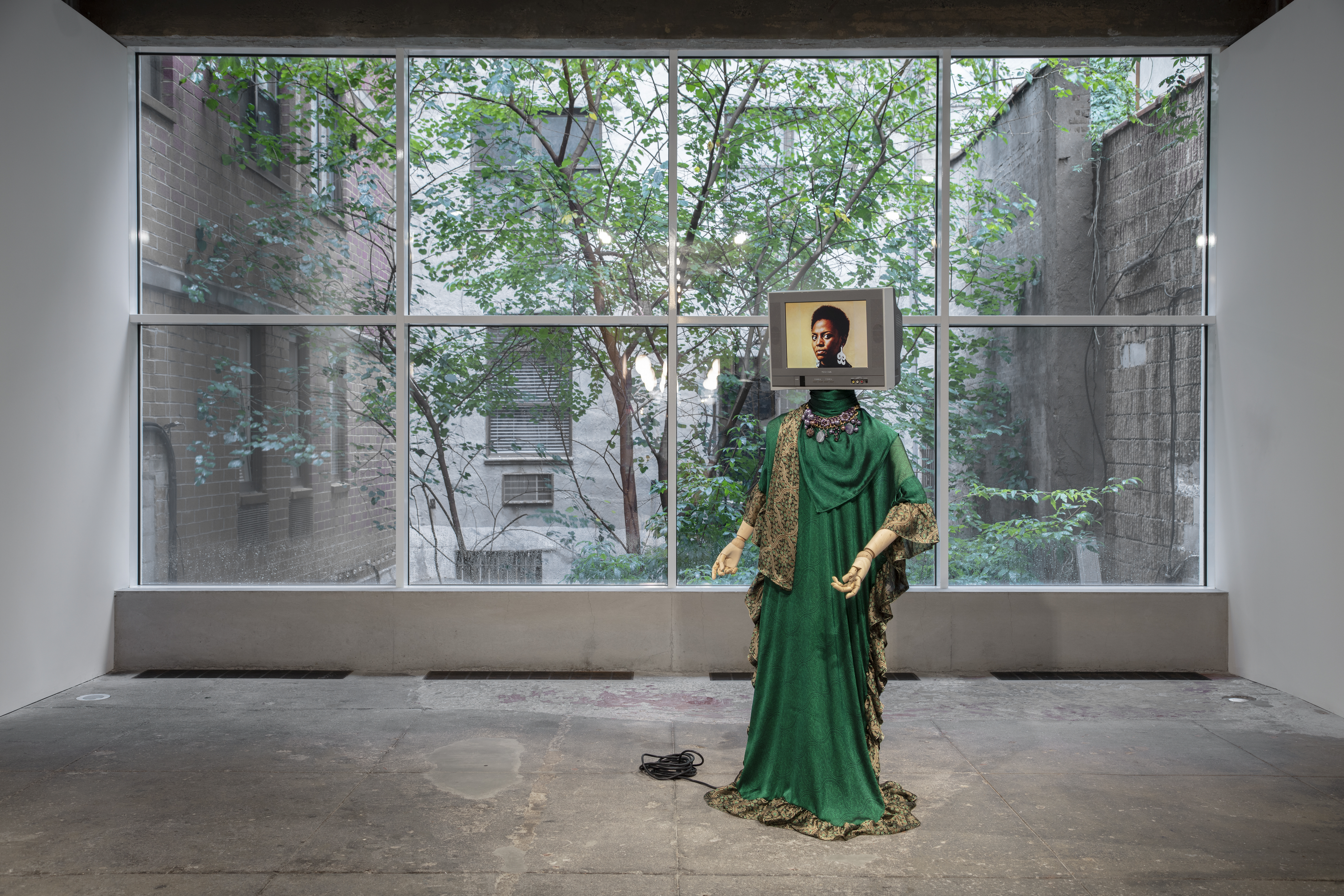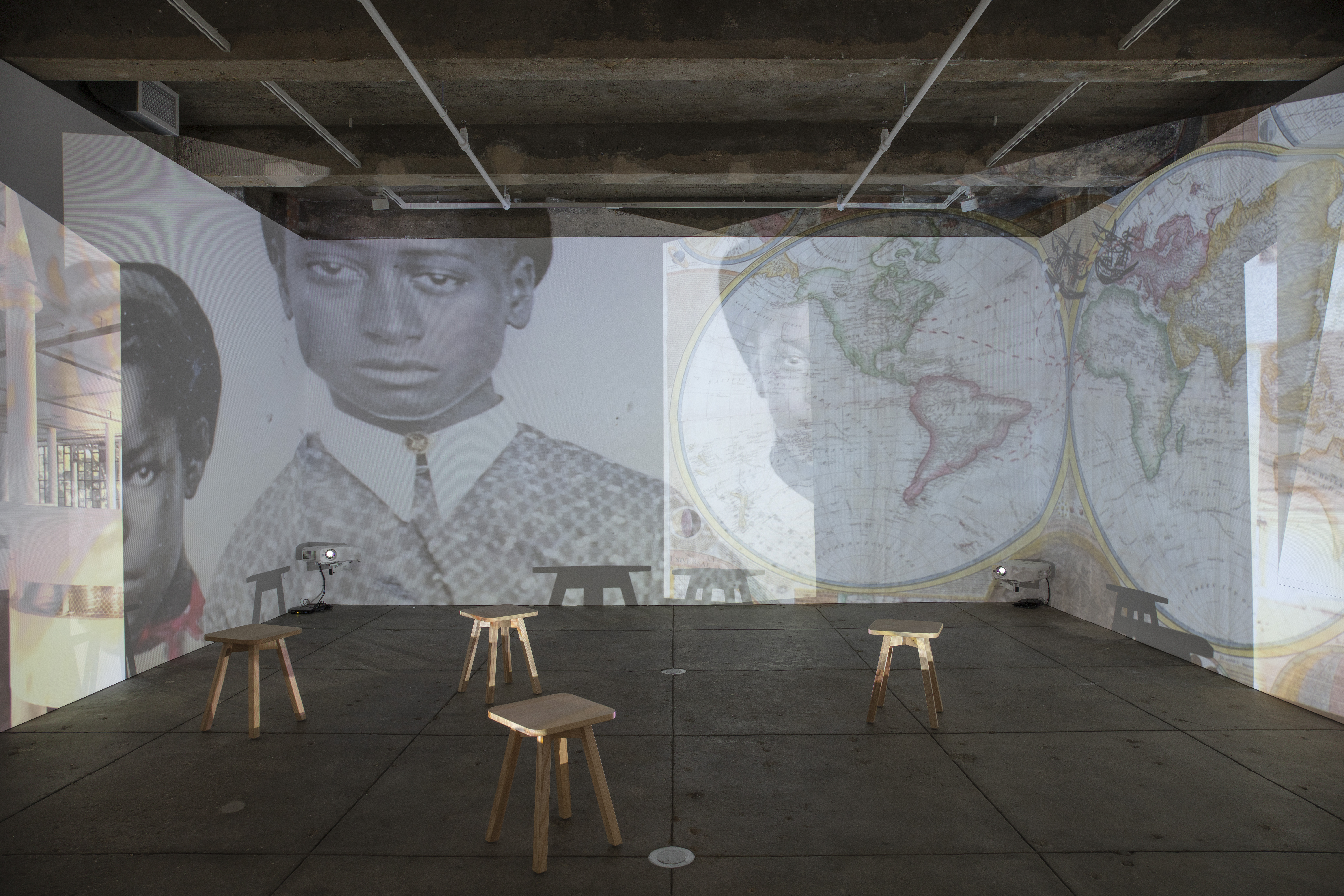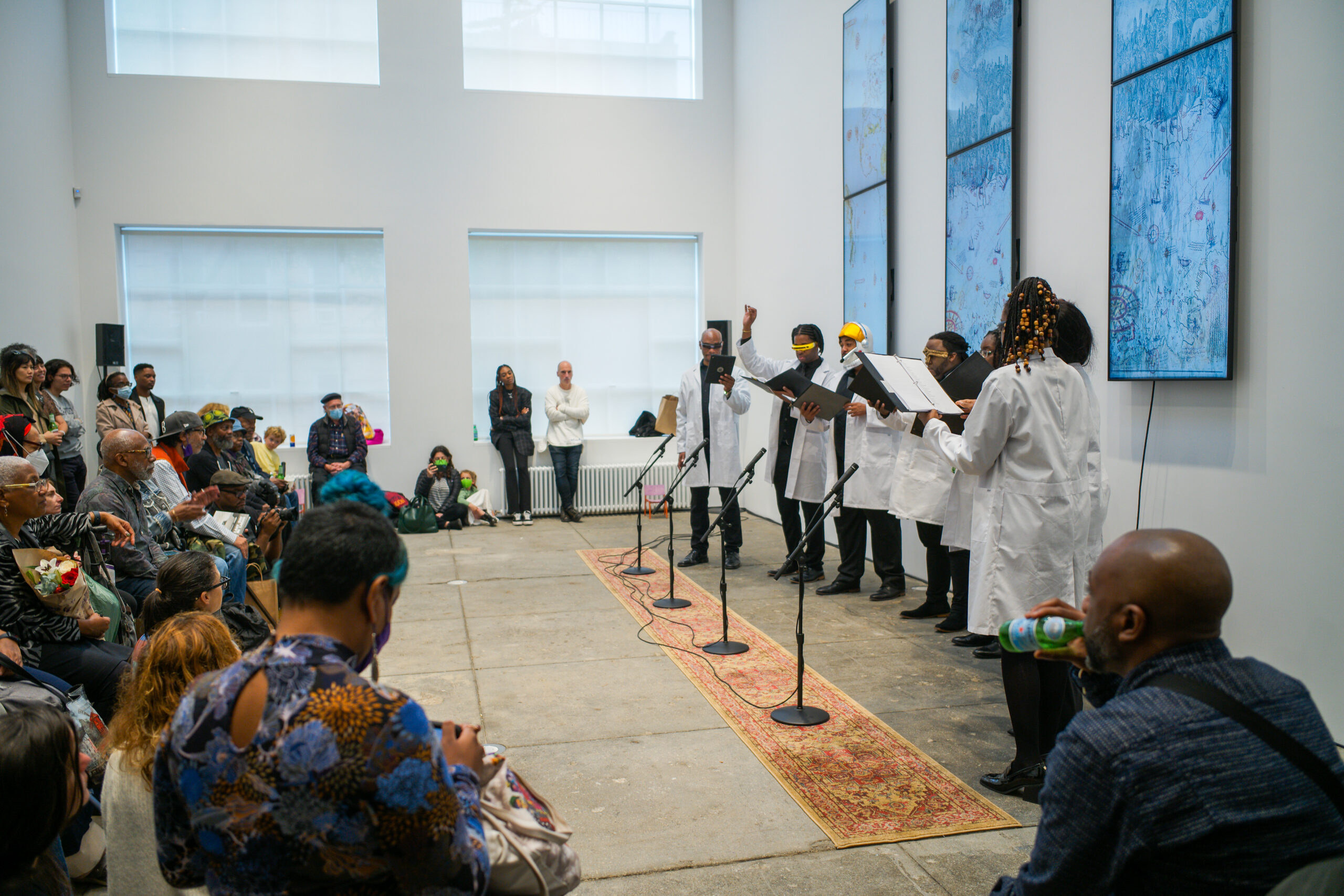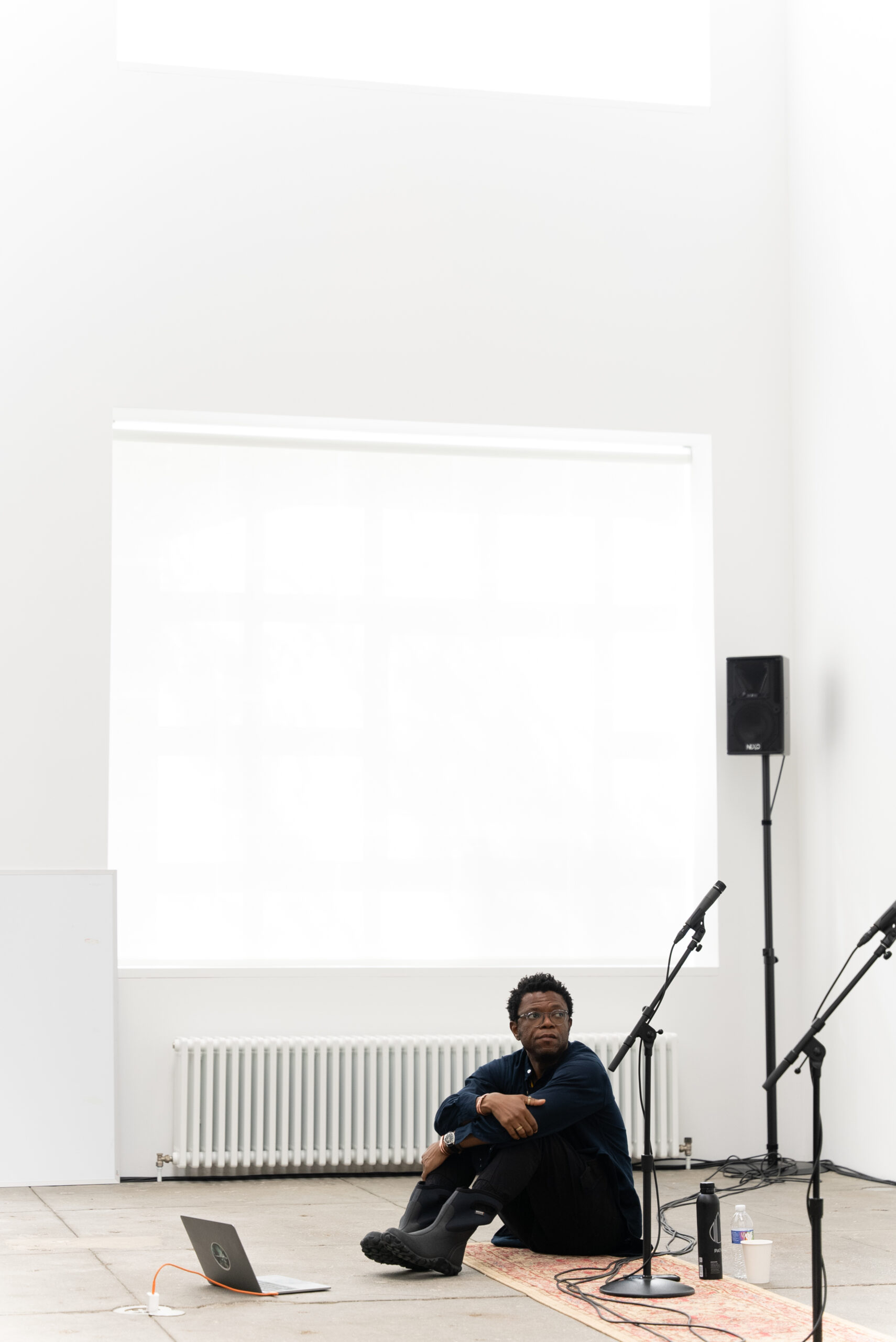Neo Muyanga: A Mass of Cyborgs
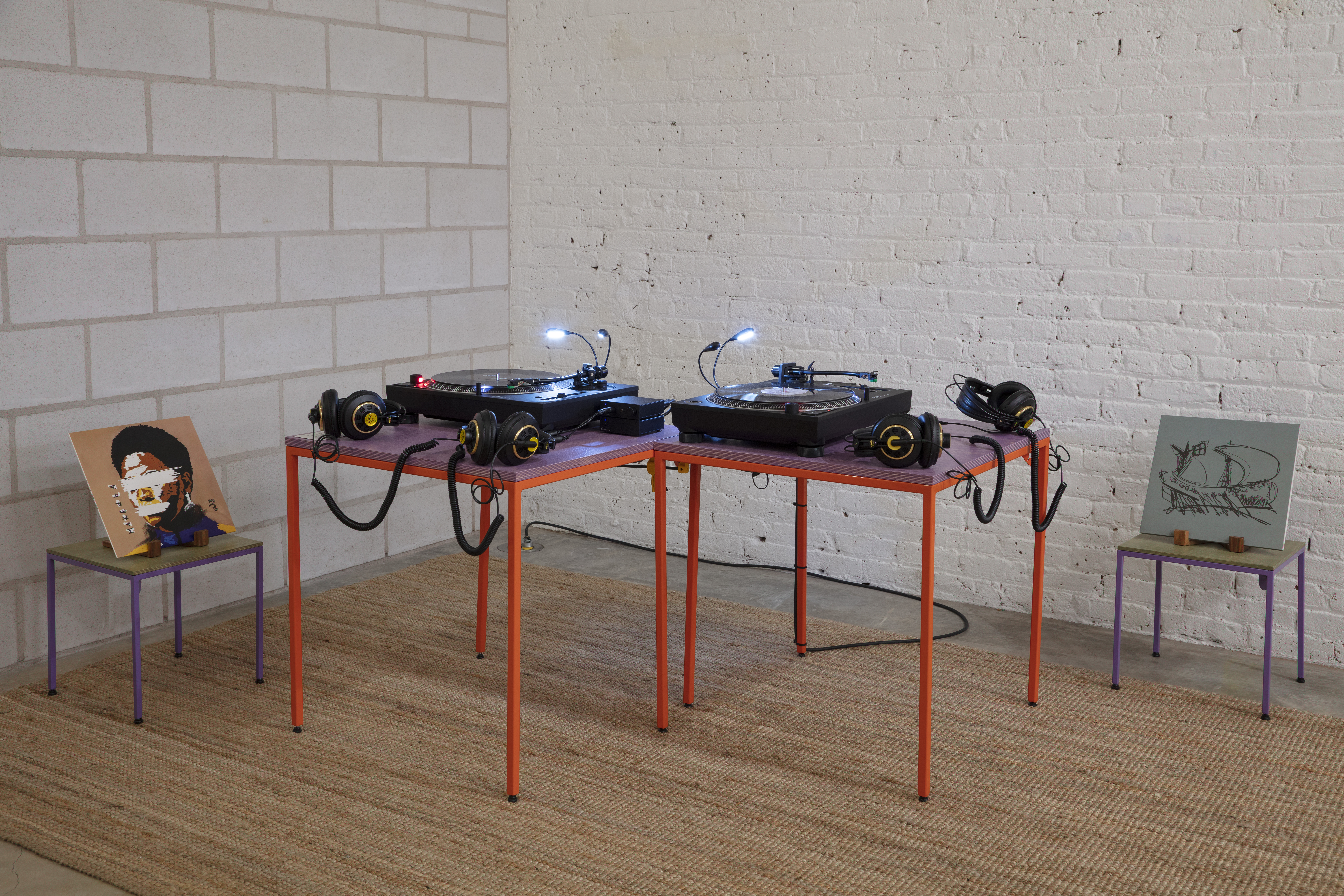
Neo Muyanga, A Mass of Cyborgs, installation view, 2022 [photo: Greg Carideo; courtesy of the artist and Center for Art, Research and Alliances (CARA), New York City]
Share:
A Mass of Cyborgs, Neo Muyanga’s first solo, is a fitting inaugural exhibition for the Center for Art, Research and Alliances (CARA), a nonprofit space focused on “un-learning, kinship, and care” that opened in New York in October 2022. Comprising recent works by the South African artist and composer, this immersive exhibition highlights the collective and generative nature of his practice; each project is the result of multiple layered collaborations that morph into various iterations. Throughout, Muyanga revives a cast of characters via textured narratives that insist upon making connections across centuries and continents, and that unfold visual and sonic topographies formed by influence and encounter.
Neo Muyanga, A Mass of Cyborgs, installation view, 2022 [photo: Greg Carideo; courtesy of the artist and Center for Art, Research and Alliances (CARA), New York City]
Audio archives—both polyphonic ones and cacophonic ones—are critical to Muyanga’s explorations. In the otherwise empty ground-floor gallery space, the viewer is greeted by a mannequin, posed as if in mid-performance, dressed in a lush emerald-green robe, and bedecked in heavy costume jewelry. A bulky silver CRT television serves as the mannequin’s head. In the 13-minute video playing there, aMa’s eYes, Mama Africa’s eyes move as if tracking the viewer, while a soundtrack blends the singer’s words with Muyanga’s own compositions. House of MAKEdbA (2019) is the artist’s tribute to Miriam Makeba (1932–2008). An intimacy develops as the viewer moves closer to the mannequin, perhaps drawn by Makeba’s hypnotic eyes. Exiled from South Africa for 30 years over her opposition to the apartheid regime, Makeba and her husband, Kwame Ture (Stokely Carmichael), became key figures in the pan-African movement while living in Guinea. Here, Muyanga honors her role in imagining and enacting new cartographies of solidarity across the African continent.
Neo Muyanga, A Mass of Cyborgs, installation view, 2022 [photo: Greg Carideo; courtesy of the artist and Center for Art, Research and Alliances (CARA), New York City]
In A Maze in Grace (2020), Muyanga explores the misunderstood origins of one of history’s most popular songs, Amazing Grace. Widely considered an anthem of the Civil Rights movement and of the American South, the 1772 hymn was in fact written and composed by John Newton—an English slave-trader turned preacher and later abolitionist—to celebrate his salvation. Footage of a collaborative performance by Khayelitsha-based mezzo soprano Tina Mene and Brazilian protest theater troupe Legítima Defesa is projected on the walls of the gallery space. Co-commissioned by the Liverpool Biennial and the Fundação Bienal de São Paulo, and filmed in the São Paolo Biennale pavilion designed by Oscar Niemeyer, this contemporary re-enactment is layered onto images that expose the song’s darker roots. The performers often find themselves stepping from the modernist rehearsal space into antique maps, tracing the journeys of their ancestors. Surrounded by these disparate projections, viewers—seated in the middle of the gallery—are able to experience the projections as being intertwined in the same narrative. Throughout this performance, Muyanga insists on exposing the violent beginning of Amazing Grace while simultaneously celebrating the resilience of the men and women subjected to this violence by connecting it to the history of Liverpool and São Paulo, and ultimately by embedding it into the histories of the transatlantic slave trade.
Both House of MAKEdbA and A Maze in Grace are accompanied by a 12-inch vinyl record, a further tribute to the forgotten histories revealed in the original artworks. Each of the album covers showcases a frame from an animated sequence—MAKEdbA in Exile and A Grace Project, respectively—by Muyanga. In the former, the singer’s eyes (previously highlighted in the video installation) and mouth are scratched, or whited out—a commentary, perhaps, on the violence of exile. And yet Makeba continued to reach audiences across the continent and the world for decades.
Neo Muyanga, Hymn to the Strange, 2022-2023, performance [photo: Mike Vitelli; courtesy of the artist and Center for Art, Research and Alliances (CARA), New York City]
Muyanga continues to chart new and layered cartographies in Hymn to the Strange (2022), which builds on his earlier collaborations with video artist Bianca Turner. On three mounted screens, digital animations create a palimpsest of connections, weaving together the interdependent routes that created and maintained the slave trade. The visual component is accompanied by a sound work, a musical collaboration with The Unsung, a New York community-based collective directed by Tyrone Clinton that draws on Muyanga’s eclectic musical expertise, which includes jazz, operettas, and Zulu and Sesotho idiomatic songs.
For the duration of the exhibition, in a series of live ongoing rehearsals, The Unsung performs like a Greek chorus, framed by the animated screens. Dressed in black with white lab coats and a variety of headgear, the futuristic ensemble transverses an expansive repertoire and a broad emotional register as the group’s members narrate their collective experience of hardship and resistance.
Neo Muyanga, Hymn to the Strange, 2022-2023, performance rehearsal [photo: Emmanuel Abreu; courtesy of the artist and Center for Art, Research and Alliances (CARA), New York City]
If Muyanga’s cyborgs defy categories and classifying, these performances may be the exhibition’s most articulate manifestation of this goal. Although A Mass of Cyborgs brings together a limited number of works, it is expansive in its range and vision, in the maps it draws. Muyanga moves between media and across continents with ease, even if the connections being made and the routes being retraced are difficult
Dina Ramadan is continuing associate professor of Human Rights and Middle Eastern Studies at Bard College and is faculty at the Center for Curatorial Studies.
